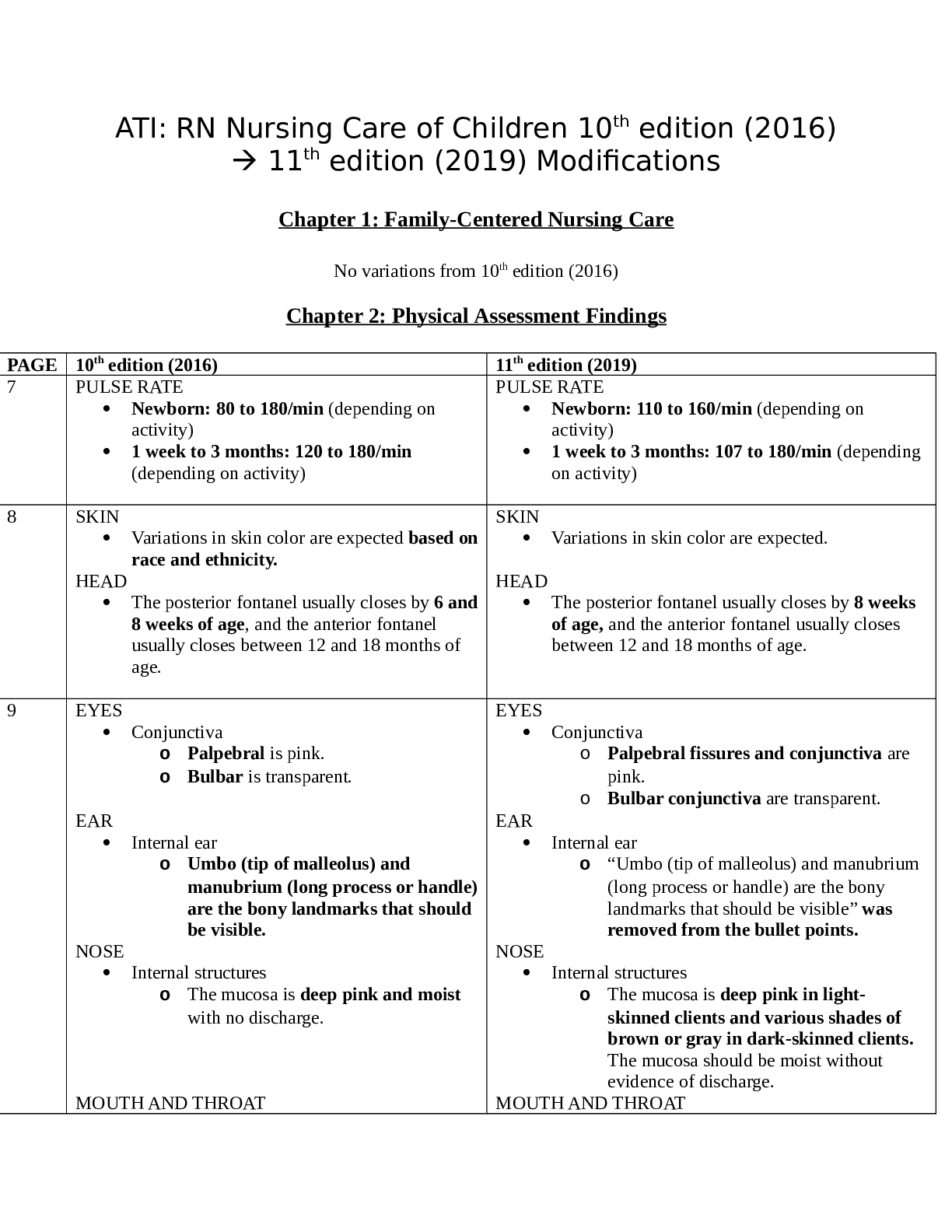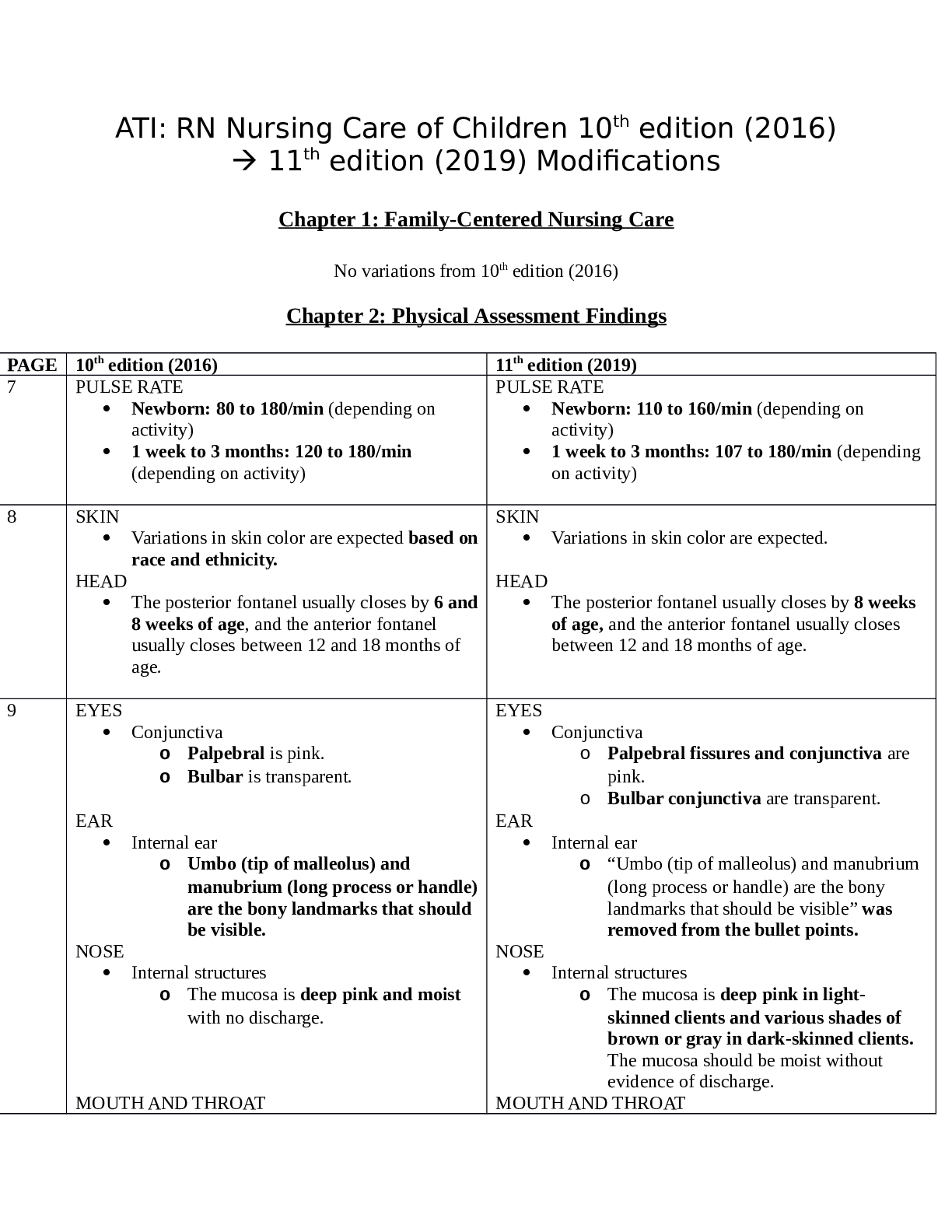Chapter 1: Family-Centered Nursing Care
No variations from 10 th edition (2016)
Chapter 2: Physical Assessment Findings
PAGE 10 th edition (2016)
7
PULSE RATE
Newborn: 80 to 180/min (depending on
activity)
1 week to 3 months: 120 to 180/min
(depending on activity)
11 th edition (2019)
PULSE RATE
Newborn: 110 to 160/min (depending on
activity)
1 week to 3 months: 107 to 180/min (depending
on activity)
8 SKIN
SKIN
Variations in skin color are expected based on
Variations in skin color are expected.
race and ethnicity.
HEAD
HEAD
The posterior fontanel usually closes by 6 and
The posterior fontanel usually closes by 8 weeks
8 weeks of age, and the anterior fontanel
of age, and the anterior fontanel usually closes
usually closes between 12 and 18 months of
between 12 and 18 months of age.
age.
9 EYES
Conjunctiva
o Palpebral is pink.
o Bulbar is transparent.
EYES
Conjunctiva
o Palpebral fissures and conjunctiva are
pink.
o Bulbar conjunctiva are transparent.
EAR
EAR
Internal ear
Internal ear
o Umbo (tip of malleolus) and
o “Umbo (tip of malleolus) and manubrium
manubrium (long process or handle)
(long process or handle) are the bony
are the bony landmarks that should
landmarks that should be visible” was
be visible.
removed from the bullet points.
NOSE
NOSE
Internal structures
Internal structures
o The mucosa is deep pink and moist
o The mucosa is deep pink in light-
with no discharge.
skinned clients and various shades of
brown or gray in dark-skinned clients.
The mucosa should be moist without
evidence of discharge.
MOUTH AND THROAT
MOUTH AND THROAT
Gums
o Coral pink
Mucous membranes
o Moist, pink, smooth, and glistening
10
INFANT REFLEXES
PALMAR
GRASP
MORO
REFLEX
STARTLE
REFLEX
EXPECTED
FINDING
Elicted by placing an
abject in an infant’s
palm.
The infant grasps the
object.
Elicted by allowing
the head and trunk of
an infant in a semi-
sitting position to fall
backward to an angle
of at least 30°.
The infant’s arms and
legs symmetrically
extend, then abduct
while fingers spread
to form C shape.
Elicited by clapping
hands or by a loud
noise.
The newborn abducts
arms at the elbows,
and the hands remain
clenched.
Gums
o Coral pink in light-skinned clients, and
various shades of brown or gray in
dark-skinned clients.
Mucous membranes
o Moist, smooth, and glistening. Pink in
light-skinned clients and various shades
of brown or gray in dark-skinned
clients.
INFANT REFLEXES
EXPECTED
AGE
Birth to 3
months
Birth to 4
months
Birth to 4
months
EXPECTED FINDING
PALMAR
GRASP
MORO
REFLEX
Elicted by placing an
abject in an infant’s
palm.
The infant grasps the
object.
Elicted by allowing the
head and trunk of an
infant in a semi-sitting
position to fall backward
to an angle of at least
30°.
The infant’s arms and
legs symmetrically
extend, then abduct
while fingers spread to
form C shape.
STARTLE REFLEX
removed from the table
entirely
EXPECTED
AGE
Birth to 4
months
Birth to 6
monthsChapter 3: Health Promotion of Infants (2 Days to 1 Year)
PAGE
15
10 th edition (2016)
PHYSICAL DEVELOPMENT
Fontanel
o Posterior fontanel closes by 6 to 8
weeks of age.
MOTOR SKILL DEVELOPMENT BY AGE
11
MONTHS
12
MONTHS
17
GROSS MOTOR SKILLS
Cruises of walks while holding onto
something
Walks with one hand held
Sits down from a standing position
without assistance
NUTRITION
Solids are introduced around 4 to 6 months of
age.
11 th edition (2019)
PHYSICAL DEVELOPMENT
Fontanel
o Posterior fontanel closes by 2 to 3
months of age.
MOTOR SKILL DEVELOPMENT BY AGE
11
MONTHS
12
MONTHS
GROSS MOTOR SKILLS
Cruises of walks while holding onto
something
Sits down from a standing position
without assistance
Walks with one hand held
NUTRITION
Solids are introduced around 6 months of age.
Chapter 4: Health Promotion of Toddlers (1 to 3 Years)
PAGE
21
22
10 th edition (2016)
PHYSICAL DEVELOPMENT
At 30 months of age, toddlers should weigh
four times their birth weights.
COGNITIVE DEVELOPMENT
Piaget: Sensorimotor stage transitions to the
preoperational stage around age 19 to 24
months.
NUTRITION
Foods that are potential choking hazards (nuts,
grapes, hot dogs, peanut butter, raw carrots,
tough meats, popcorn) should be avoided.
11 th edition (2019)
PHYSICAL DEVELOPMENT
At 30 months of age, toddlers should weigh four
times their birth weights. Toddlers grow
approximately 1.8 to 2.7 kg (4 to 6 lb.) per
year.
COGNITIVE DEVELOPMENT
Piaget: Sensorimotor stage transitions to the
preoperational stage around 2 years of age.
NUTRITION
Foods that are potential choking hazards (nuts,
grapes, hot dogs, peanut butter, raw carrots,
dried beans, tough
Read More


